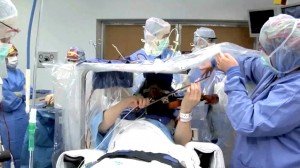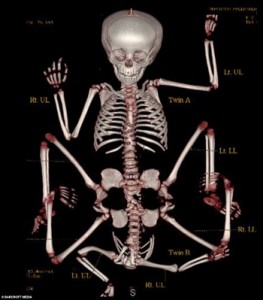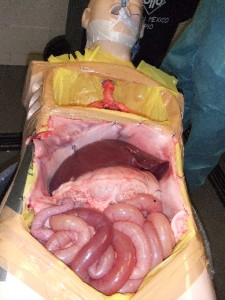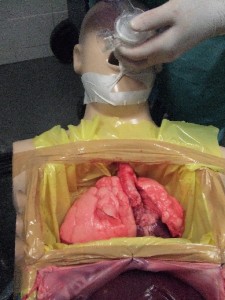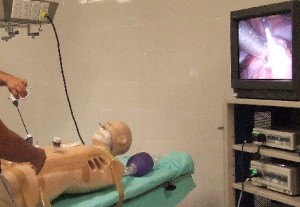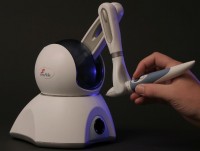Roger Frisch, a solo violinist and associate concertmaster for the Minnesota Orchestra, and how he came to Mayo Clinic and Dr. Kendall Lee (neurosurgeon) for relief of a career-threatening tremor.
Category: Medical video
Succesful surgery in a Girl with eight limbs
Lakshmi is the hindu goddess of of wealth, fortune, love and beauty, the lotus flower and fertility. She is represented by an icon of a lady with four arms.
Lakshmi Tatma is a girl who is two years old but she was born with 8 limbs, because she is joined at the pelvis to what is, in fact, a headless, undeveloped twin (parasitic twin or to be more specific, ischiopagus cojoined twin).
This is surely an abnormal feature and it has attracted media attention worldwide.
The 24-hour-long surgery to remove the extra limbs of this Indian girl born with four arms and four legs was a success, doctors announced Wednesday.
A team of more than 30 physicians removed Lakshmi’s extra limbs, salvaged her organs, and rebuilt her pelvis area, Dr. Sharan Patil said from a hospital in the southern Indian city of Bangalore, India.
Surgical model
This surgical model is made of glass fiber and has abdominal and thoracic compartments separated. A selective bronchial intubation can be done in this model. It also has a structure that simulates a diaphragm. You can perform both laparoscopy and thoracoscopy.
The organs of a pig are placed within the model.
The model is intubated with an “orotracheal” tube
A woman survived internal decapitation
On January 25th, a car crash took place in Nebraska and Shannon Malloy (a previously healthy 30 year old woman) was seriously injuried. Her skull became separated from her cervical spine, this is what is called internal decapitation.
“I remember the impact and then I had no control over my head… I wasn’t focused so much on the pain. I just kept thinking, ‘I have to stay alive,'” said Shannon.
5 screws were drilled into Shannon’s neck and 4 more were drilled into her head to keep it stabilized. Then a thing called a halo (rods and a circular metal bar around her head) was attached for added support. It’s not exactly a pain-free procedure.
Shannon Malloy still has a long, costly recovery ahead. A fund has been set up in Malloy’s name at Wells Fargo banks. You can make donations at any location under the “The Benefit of Shannon Malloy.”
Anorexia, Bulimia & Body dysmorphic disorder
Lets think about this disorders.
ABKontaktTheMirror
Uploaded by baronrojo
Surgery Simulator
Via Wired News
Is it possible to train yourself in a virtual patient?
A short answer is Yes.
In India, Professor Suvranu De is developing a surgery simulator with help of this couple of devices:
Sounds nice, but… I personally believe that you cannot train yourself in a virtual environment because there are not virtual patients nor virtual diseases. There are certain things that cannot be learned that way. Human body and human organs manifest in different ways in disease and wellness, as the number of people on earth.
Here is an example of the SimSurgery:
Have you ever seen a virtual fever or cancer? I don’t.
The basics of minimally invasive surgery skills could be learned in virtual environments (like learn for the first time the spatial skill in angle laparoscopes). From there to the point of learn certain procedure in a simulator, it’s a long way.
Perhaps this kind of technology can have some applications, but we don’t have to hurry and change what it has been proven for years… although somebody call us old fashioned.
What do you think about surgery simulators?
Dr. Jon Mikel Iñarritu
Worst case of hemorrhoidal prolapse ever & PPH
BEWARE! Gory image
A 45 year old male with history of chronic reducible hemorrhoidal disease came to the emergency department with excruciating pain, rectal bleeding and an anal non-redicible mass after a bowel movement.
On examination, we found this:

In this case, the only way to reduce the prolapse is a procedure for prolapsing hemorrhoids (PPH) which is an innovative approach to the management of enlarged, prolapsing hemorrhoids. Rather than rely on excision of the complexes, the primary goal is to reduce the hemorrhoidal tissue and anoderm to the correct anatomical location within the anal canal. It is important to keep this goal in mind, because the misinterpretation of anodermal migration externally as external hemorrhoids leads to unnecessary excision of sensate skin during PPH. In fact, with a correctly performed procedure, the relocated anoderm will shrink over time.
For this, we need an hemorroidal circular stapler kit which includes: clear plastic anoscope, half-slit anoscope, suture threader, and the 33 mm stapler.
Here is an animation video of how the procedure works, and how does the anal canal looks like before and after the procedure.
Regards,
Jon Mikel Iñarritu, M.D.
More information of hemorrhoidal disease in this site is here:
Thrombosed Hemorrhoid
